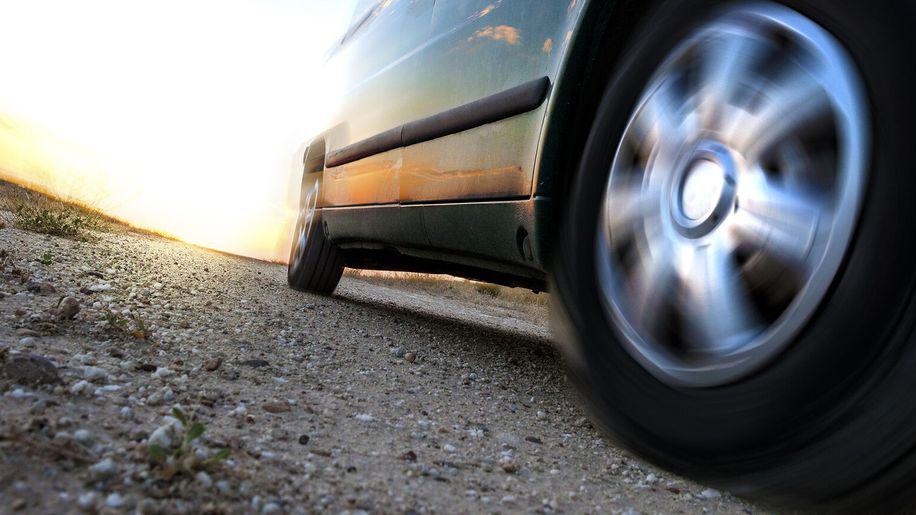What is rolling resistance?
First things first, let’s be sure we understand the idea of tyre rolling resistance. As its name would suggest, rolling resistance refers to the resistance experienced by your car tyre as it rolls over a surface. The main causes of this resistance are tyre deformation, wing drag, and friction with the ground.
The higher the rolling resistance is, the more energy to overcome it is needed. Hence a considerable impact of tyre rolling resistance on fuel consumption (and on how long your tyres will last). A 30% increase in rolling resistance generates between 3 and 5% of fuel overconsumption.
Several elements have an effect on rolling resistance: tyre pressure, tread, diameter, width, or the materials used in tyres or their construction. Regarding tyre pressure for instance, studies carried out on French roads (1) have shown that more than 50% of cars run at least 0.3 bar below the required tyre pressure. This results in a considerable increase in rolling resistance: +6% for an underinflation of 0.3 bar and +30% for underinflation of 1 bar.

Tyres are also about grip
However, tyre resistance is nonetheless necessary. Part of rolling resistance caused by friction between the road surface and the tyre results in traction, and grip is essential to safety. Traction is the force required to generate motion – causing the tyre to roll across a surface rather than spinning in one place.
So you do need rolling resistance, but not the loss of energy through heat that it creates. Is it possible to have both low rolling resistance AND a good grip in the same tyre?
What are winter tyres?
Winter tyres are the opposite – these are specifically designed for safe driving in temperatures below 7 °C, and severe conditions such as ice and snow. Compared to summer tyres, winter tyres have a distinctive tread pattern with deeper, more numerous notches to improve traction on snow and ice. They’re also made of a more supple material, helping them stay soft enough to grip the road even in freezing temperatures.
Here come the Low Rolling Resistance tyres!
Low Rolling Resistance tyres – also known as LRR - are therefore designed to reduce energy dissipation – and therefore save fuel. This is done through innovations applied to all aspects of the tyre:
- Tyre construction, shape, and tread pattern: the architecture of the tyre through the geometry and nature of the internal plies and the design of the treads have a huge influence on the extent of the deformations undergone by the tyre, and thus on rolling resistance.
- The weight of the tyre: for the same deformation, the more massive an object is, the more it heats up.
- The optimization of rubber mixtures and the various components used in the tyre: it’s a major source of progress in reducing the energy absorbed by the tyre.
MICHELIN e.PRIMACY: low rolling resistance car tyres
The most efficient in its category (2) in terms of rolling resistance, the MICHELIN e·PRIMACY tyre combines both excellent rolling resistance and great braking performance. Rolling resistance translates into 3 benefits: reduced fuel consumption, fewer CO₂ emissions, and greater range.
At the same time, MICHELIN e·PRIMACY delivers great wet braking performance and for a long period of time. Even after 30,000 km, it passes the standards expected of a new tyre. Overall, only 1% of tyres succeed in combining this level of rolling resistance (A) with the level of wet braking (A/B).
Regarding fuel consumption, how much difference do low rolling resistance tyres make?
“A tyre’s fuel consumption represents one full tank in five” Cyrille Roget, Science and Innovation Communications Director at Michelin, explains. “This is linked to the tyre rolling resistance. And it’s not insignificant, if you think about the amount of fuel we put in our tanks. So the right tyre can really help you save money.”
To be specific, thanks to the MICHELIN e·PRIMACY tyre’s low rolling resistance, drivers save around 0.21 litres of fuel per 100 kilometres and around €80 over the life of the tyre (3). For an electric vehicle, range is increased by an estimated 7% compared to other tyres of its category – that’s 30km, for an estimated 400km range (4).
Are low rolling resistance tyres worth it?
It’s not just your wallet that benefits from improvements in fuel efficiency thanks to low rolling resistance tyres. They are also a step towards more eco-friendly driving. When it comes to a combustion engine, by reducing fuel consumption, you also cut down on your use of fossil fuels. And, for an electric motor, greater range means less demand on the electricity grid which, in Europe, gets 40% of its energy from power stations burning fossil fuels.
How to find out the rolling resistance of a tyre
When purchasing a tyre in Europe, you can find the rolling resistance grade on the label. There are three parameters: tyre energy efficiency (which tells you about the rolling resistance), tyre wet grip, and tyre noise levels. From May 1, 2021, these labels will be updated: with classifications ranging from A to E, new snow/ice performance icon, and a QR code giving access to the EU tyre database EPREL. Find out more on how to read the European tyre labels!
Legal mentions
(1) Data collected on French motorways in 2000, during MICHELIN "Fill up the air" operations.
(2) MICHELIN e.Primacy category of tyres is defined as one of the Premium summer tyres such as CONTINENTAL, GOODYEAR,BRIDGESTONE, PIRELLI, DUNLOP brands, and which are not dedicated to Original Equipment application (i.e not designed to achieve car manufacturers specific targets) but tyres that can be purchased from retailers.
Rolling Resistance test - Rolling Resistance tests conducted on machine by Applus Idiada, on Michelin's request, June (on new) & August (on 2mm buffed) 2020, on dimension 205/55 R16 91V, comparing MICHELIN e.PRIMACY (new: 5.58kg/t & worn: 5.13kg/t) versus MICHELIN PRIMACY 4 (new: 7.74kg/t & worn: 6.25kg/t) ; BRIDGESTONE TURANZA T005 (new: 7.17kg/t & worn: 5.81kg/t) ; CONTINENTAL ECOCONTACT 6 (new: 6.39kg/t & worn: 5.49kg/t) ; CONTINENTAL PREMIUM CONTACT 6 (new: 8,93kg/t & worn: 6,94kg/t) ; DUNLOP BLURESPONSE (new: 7.97kg/t & worn: 5.54kg/t) ; GOODYEAR EFFICIENT GRIP 2 (new: 7.01kg/t & worn: 5.38kg/t) ; PIRELLI CINTURATO P7 BLUE (new: 6.96kg/t & worn: 6.30kg/t) ; PIRELLI CINTURATO P7 (new: 8.79kg/t & worn: 6.97kg/t).
(3) When new, MICHELIN e·Primacy generates 2kg/t on average Rolling Resistance less than competitors, equivalent in fuel consumption reduction of up to 0,21l/100km, equivalent of a reduction in CO₂ emission up to 5g for a VW Golf 7 1.5 TSI or equivalent of reduction of up to 7% in autonomy for a VW e.Golf.
During usage, MICHELIN e·Primacy generates 1,5kg/t on average Rolling Resistance less than competitors, reduction is equivalent of up to 80€ savings on fuel. This reduction is equivalent of up to 174kg of CO₂ saved. Usage reductions are estimated on the average of new and buffed 2mm data to take into account real life time performance -All reductions are estimated on a base of 35 000km and a fuel price of 1.46€/L (https://ec.europa.eu/energy/data-analysis/weekly-oil-bulletin_en 6/1/2020 weighted on the top 10 countries for motor vehicle movements on national and foreign territory - https://ec.europa.eu/ eurostat/web/transport/data/database). Actual fuel and cost savings may vary depending notably on driving habits, vehicle or tire pressure,
(4) Increased EV battery range and CO₂ reduction. When new, MICHELIN e.PRIMACY generates 2kg/t on average Rolling Resistance less than competitors, equivalent in fuel consumption reduction of up to 0.21l/100km, equivalent of a reduction in CO₂ emission up to 5g for a VW Golf 7 1.5 TSI or equivalent of reduction of up to 7% in autonomy for a VW e.Golf.




